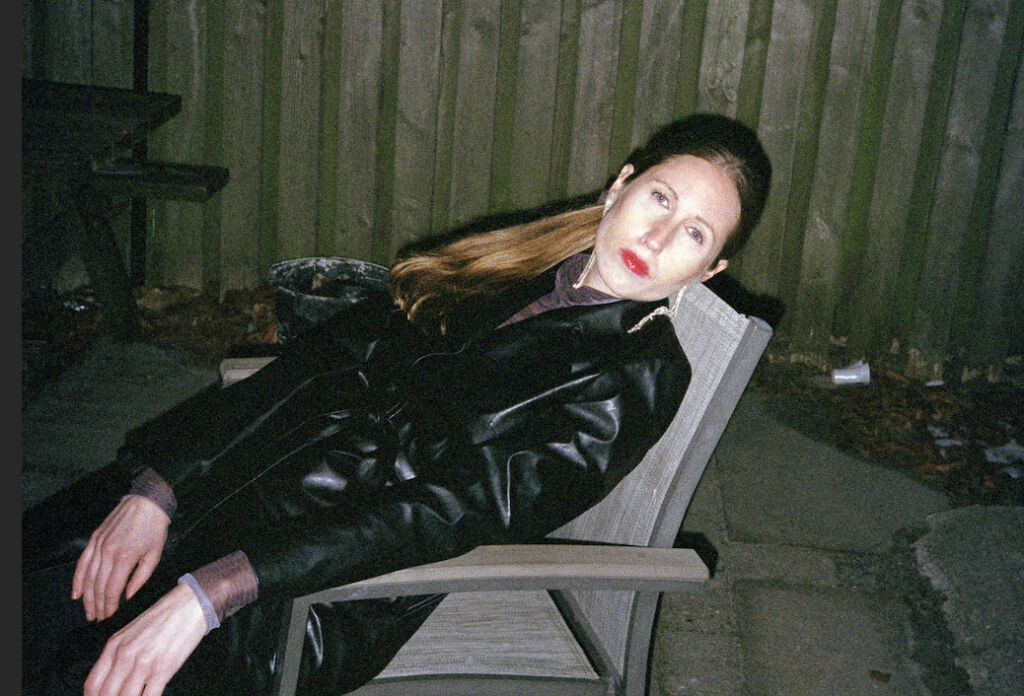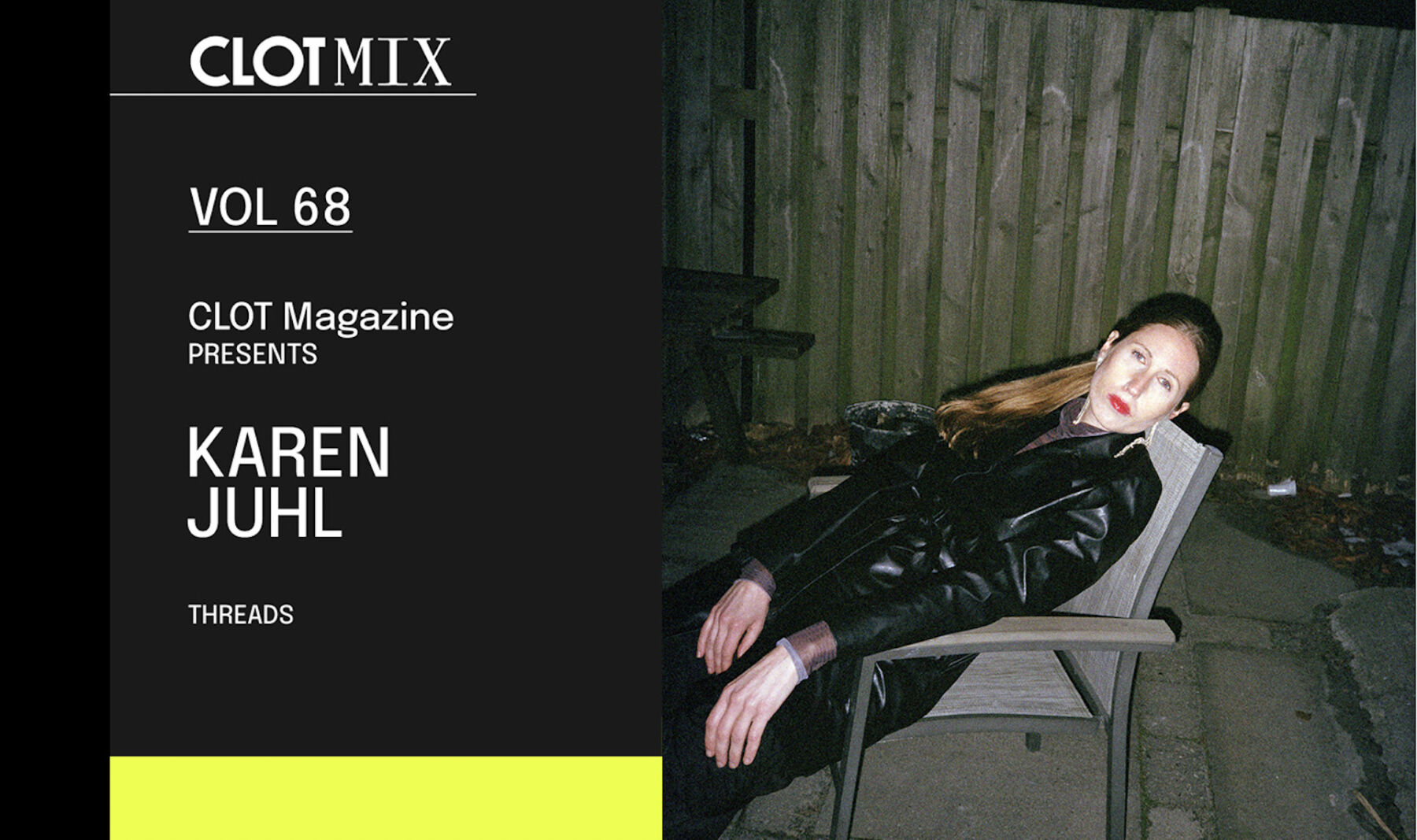Text by CLOT Magazine

Our new mixtape comes from Copenhagen-based experimental R’n’B artist Karen Juhl. Her influences span from the likes of Laurie Anderson and Holly Herndon to Solange. Juhl is interested in exploring different approaches to songwriting in the 21st century, her style ranging from experimental electronics and contemplative poetry to antithetical rap.
Her debut album Mother Tongue, released by Inklingroom in September, is a dynamic manifestation of her self-written poems and diary entries. The album explores ideas of fragility within a hyper-globalised world, shifting in dynamics from intensely noisy and emotive to calm and reflective. When explaining her process of making the album, Juhl stated that ‘I brought diary notes and prose poems with me into the studio and worked on vocals in a stream of consciousness kind of way.’
The album was released on the London-based art platform inklingroom and worked on with fellow collaborator Johan Feierskov. Using mainly YouTube samples, MIDI instruments and vocals, the album feels incredibly fresh and immersive. The dysphoric and euphoric elements that occur between the music and the voice reflect the contrast and overlap in topics; from personal in relation to politics and gender in relation to time, the songs travel between childhood scenes, psychiatric wards and internet rooms.
The mixtape that Karen Juhl has created for us, entitled Threads, is described by herself as ‘a mix of moods, ideas, sounds, songs, and states. It’s full of life, cuz it unfolds in the same way life does, forward and through unforeseen terrains. I wanted to honour sounds on the verge of becoming. My compositions “Face Wash” and “Home” were composed and recorded in this somewhat improvised manner. I delved further into my personal playlists, but I also asked my two close colleagues and friends Laust and Johan to share some of their magical memos with me.’
Juhl wrote the song Home about her experience of needing to connect after therapy and made the sounds subtle yet separate from one another in order to portray what she was feeling through this period, and Face Wash about her mother, which captures her past life in a meditative soundscape. Both songs are very personal and seem to evoke both harmony and obscurity, thus working symphonically with the rest of the tracks on the mixtape.
Juhl presents her mixtape as ‘a gentle framework that holds something beautifully frayed—loose threads that just barely come together to form a picture.’
Your debut album, Mother Tongue, is released on the London-based label Inklingroom. In this album, you blend elements of R’n’B, rap, experimental composition, and folklore. What were you exploring both technically and conceptually with this album, if at all?
I have explored the internal music of the lyrics, to put it in a somewhat fancy way. For example, the arrangement idea for “Face Wash” arose from the idea of the lyric, which works with layering as a concept. I kept the overall sound very minimal to create more space for shifts in vocal phrasing. All roles were thought of and written as voices, something that should be allowed to breathe and exhale.
On the other hand, a song like “Mother Tongue” is cut very harshly and gasping for breath. Here, I was interested in the musical energy that balances between hardness and helplessness, aiming to exaggerate the expression and almost make it fall apart. With this album, I wanted to create songs that could accommodate different voices, types of lyrics, and temperaments – ones that could be true to the dynamics and contradictions of a lived life while still feeling like a cohesive whole.
In your practice, you explore how songwriting can sound in the 21st century, often combining electronics with spoken word vocal prose. “Mother Tongue” reflects your universe and is centred around your self-written poems and diary entries. What was your creative process for this release?
I had written a number of lyrics, which I then began to compose songs from. The studio work took place over an extended period, with composition, production, and recording overlapping. It evolved into an album over time; the beginning was much more chaotic and intuitive, I believe. Part of the album’s origin story is that I went through a life crisis, lost control of my life, and felt like I was losing my own narrative in a way. I had a sense of needing to start over with something.
In many ways, this album became a part of starting over with something. Perhaps starting over with the way of storytelling, trying to escape the idea of a clear identity and expression. I come to think of Deborah Levy, who in her latest trilogy describes how she tried to create a female protagonist who is neither greater nor lesser than herself. I can relate to that intention.
In addition to the album release, an art book will be created in collaboration with graphic designer Paw Poulsen, combining the album’s lyrics with digital collages. Could you tell us more about this collaboration and how your work complemented each other?
I wanted to create a space outside the digital world where the experience of the work could take on a different character. More intimate, and slower, where the listener becomes a reader. In our first meeting, I shared my vision with Paw. I had been playing with creating mantra-like drawings and asemic writing for a while and was quite fascinated by the interplay between handwriting and digital writing, somewhat similar to the contrast between the human voice and digital sound sources. It was important to me that the dialogue between the physical and digital was a recurring theme.
Paw quickly tapped into my universe. Together, we translated the work’s approaches into visual parameters: dynamics through font size, cutting, use of digital ready-made, and layering. From there, Paw took over, created collages, and designed the book. It was amazing to follow his work and have such a sharp and creative mind to create something in line with my own work. Additionally, Paw taught me a lot about how colours sink into paper in different ways. We sat and contemplated shades of blue for an hour perhaps. It was one of the more nerdy days of my life.
What are your primary inspirations for your artistic practice these days? What has excited you the most recently?
I’m currently quite fascinated by clay. Clay is quite ingenious. Combined with some design and fire, it can become so much: containers, instruments, and writing boards. I had an intense afternoon on the internet, where I discovered all sorts of clay flutes. I found the idea of making music from the earth very poetic. I’ve also been interested in performative works based on a collective creative process lately.
I did a project at the Glyptoteket Museum in Copenhagen in the spring, where I integrated my work into an architectural context and worked more as a “director-composer.” It was a completely different creative mode than my more DAW-focused projects, and it’s something I’m definitely not done exploring.
What is your relationship with technology nowadays, and how do you deal with technology (screen/digital) overload?
Oh, I have an ambivalent relationship with technology. On one hand, my computer is probably my most important tool, and I spend many working hours with it every day. But I also try to maintain a somewhat distant relationship with it, where I attempt to keep control over its use – no notifications, set times for checking emails, etc. – to preserve my ability to focus. It’s one of the most precious things I have. Whether I succeed, I’m not so sure, but it’s at least the ideal.
I invest quite a bit of energy in managing it, and building discipline around it. It’s easy to forget the business layer and ignore the cognitive manipulation associated with our use of the internet and digital technologies. It affects the senses and the brain in ways we probably don’t fully understand the extent of. It’s also not something we like to be reminded of – that we are not the free political consumers we tell ourselves we are.
That said, I’m just as entangled in the use of technology as everyone else, but I believe it’s necessary to safeguard offline spheres, and screen-free spheres – especially in learning environments – not to create a nostalgic time capsule but to continue strengthening critical thinking about the use of technology.






